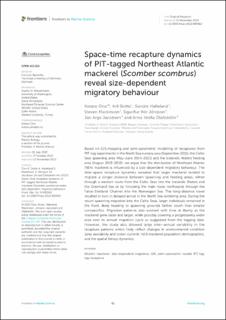Space-time recapture dynamics of PIT-tagged Northeast Atlantic mackerel (Scomber scombrus) reveal size-dependent migratory behaviour
Ono, Kotaro; Slotte, Aril; Hølleland, Sondre Nedreås; Mackinson, Steven; Jónsson, Sigurður Þór; Jacobsen, Jan Arge; Ólafsdóttir, Anna Heiða
Peer reviewed, Journal article
Published version
Permanent lenke
https://hdl.handle.net/11250/3043959Utgivelsesdato
2022Metadata
Vis full innførselSamlinger
- Articles [3012]
- Publikasjoner fra CRIStin [3070]
Sammendrag
Based on GIS-mapping and semi-parametric modelling of recaptures from PIT-tag experiments in the North Sea nursery area (September 2011), the Celtic Seas spawning area (May-June 2014-2021) and the Icelandic Waters feeding area (August 2015-2019), we argue that the distribution of Northeast Atlantic (NEA) mackerel is influenced by a size-dependent migratory behaviour. The time-space recapture dynamics revealed that larger mackerel tended to migrate a longer distance between spawning and feeding areas, either through a western route from the Celtic Seas into the Icelandic Waters and the Greenland Sea or by following the main route northwards through the Faroe-Shetland Channel into the Norwegian Sea. This long-distance travel resulted in turn in delayed arrival in the North Sea wintering area. During the return spawning migration into the Celtic Seas, larger individuals remained in the front, likely heading to spawning grounds farther south than smaller conspecifics. Migration patterns also evolved with time at liberty as the mackerel grew older and larger, while possibly covering a progressively wider area over its annual migration cycle as suggested from the tagging data. However, the study also showed large inter-annual variability in the recapture patterns which likely reflect changes in environmental condition (prey availability and ocean current), NEA mackerel population demographics, and the spatial fishery dynamics.
